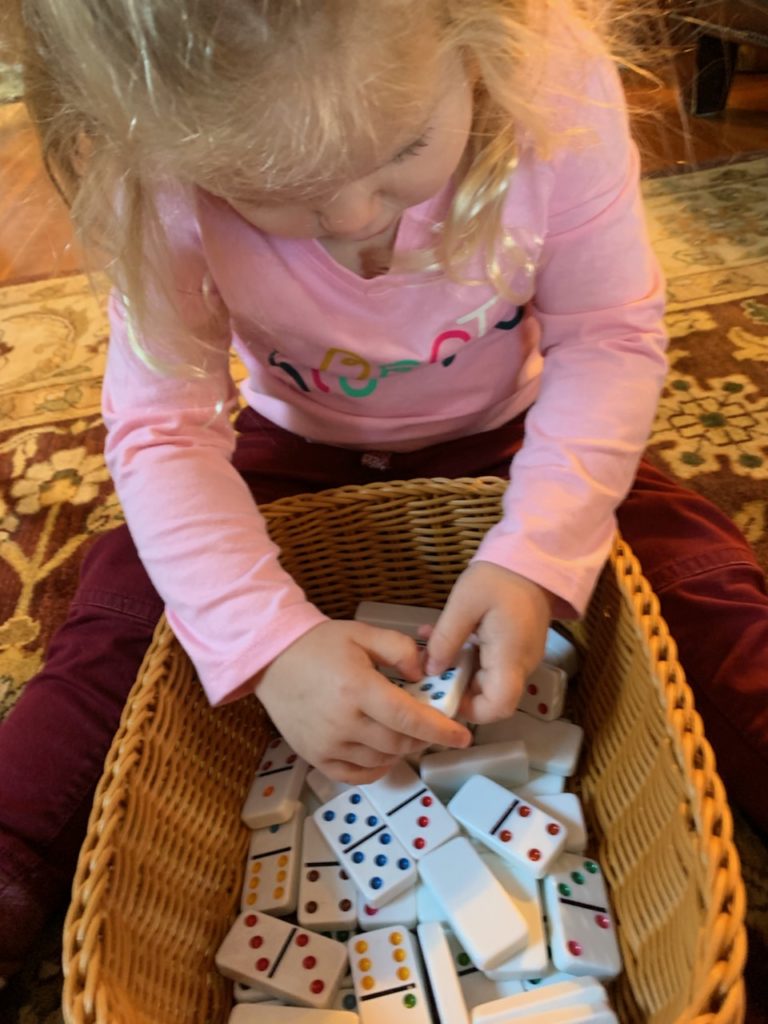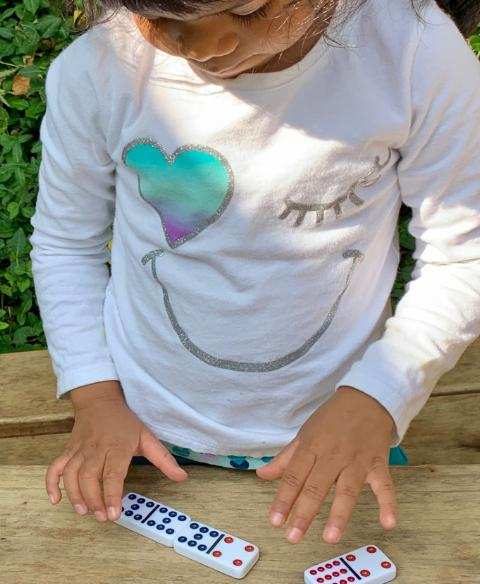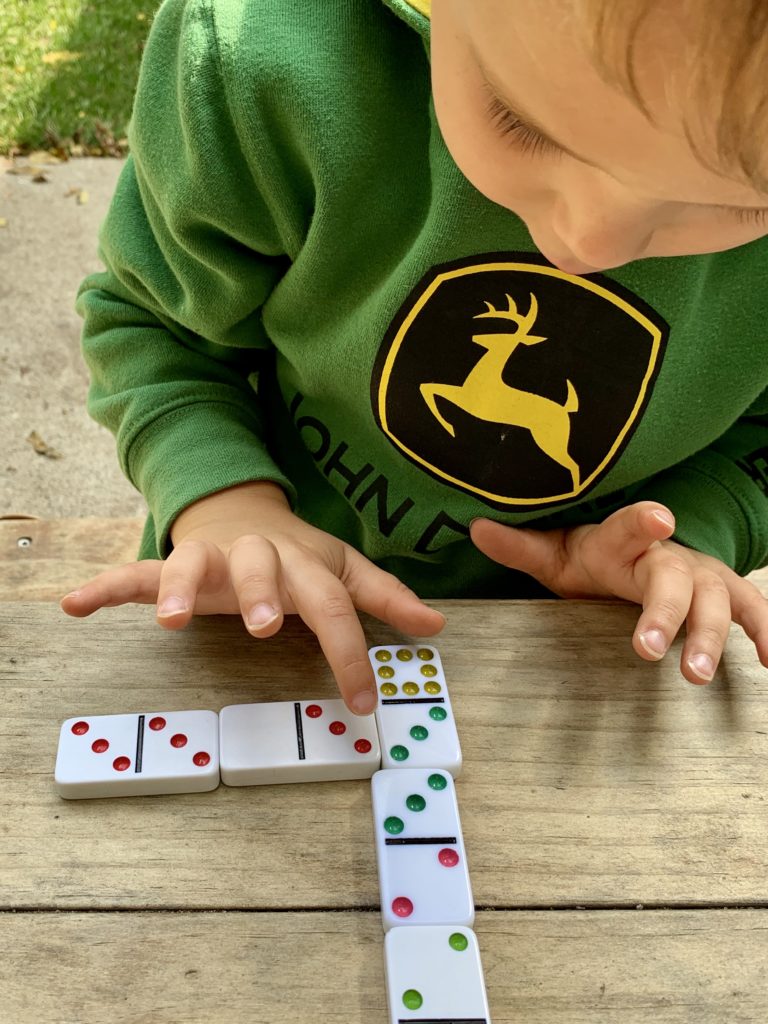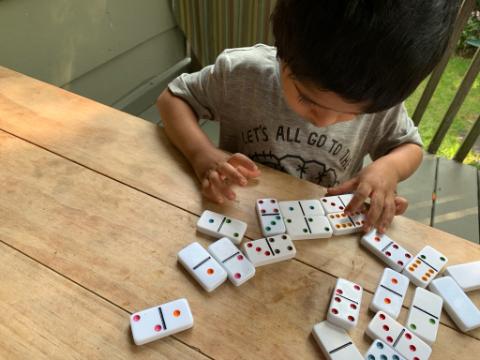STEM Play with Dominoes

“Hey, Evelyn! Go get your cell phone and meet me at the stumps!” calls Noa.
My head whirls around as I check the classroom to see if a cell phone has actually made its way into school today. Then I see Evelyn running to the basket of dominoes to get her “cell phone.”
Whew! Instant relief and a touch of humor added to my day.
Dominoes have been around for centuries. They’ve been used for all sorts of games around the globe. We have baskets of dominoes scattered around the classroom. We use them for everything from building and matching to chain reactions. I’m fairly sure that we’ve never played an actual game of dominoes with these versatile learning tools!
I love these little blocks. Whatever the game, dominoes are always a Developmentally Appropriate Play (DAP) item, regardless of the ages of the children playing with them.

This morning’s “cell phone” incident got me thinking about Developmentally Appropriate Practice.
We need to trust that the teachers who work with young children on a daily basis know what’s appropriate for these children and understand how they use their materials.
Dominoes may not be designed for toddlers and preschoolers—and may even be considered to be Developmentally Inappropriate if used as intended.
Yet, by adding dominoes to our play areas and using them as manipulatives and loose parts, we can expose our early learners to a wealth of STEM learning opportunities such as building, counting, matching and even dramatic play.

Whether we’re building with our dominoes or standing each domino on end to create a chain reaction, we are laying the foundation for strong math and science skills.
This is when parents and administrators may misconstrue active learning for mere play.
When this happens, it’s our responsibility to help parents and administrators “see” the learning that is taking place. Show them how their children are developing spatial skills and an understanding of concepts such as “location” and “ordinal position.”

“Wow, Michela, your tower is getting really big!” Jameson stops to watch as Michela carefully adds another block to her structure.
Jameson has been struggling to build a tower that rivals Michela’s in height. “My tower is too wobbly,” he moans. “It keeps falling down. It’s impossible!” He stomps his foot in frustration and crosses his arms over his chest.
“You need to go very slow, like this,” responds Michela without taking her eyes off of her tower.
Michela is demonstrating the practice of science and engineering. We have geometry unfolding before our eyes as Michela uses symmetry, visualization, spatial reasoning and geometric modeling to solve problems such as balance and continuity.
By observing and asking questions, sharing ideas and solving problems, the children are working as a team to build a greater understanding of what works and what doesn’t.
This is a form of early data collection. If you are studying force and motion, a domino chain reaction is a great activity to demonstrate potential and kinetic energy.
![]()

I watch as four-year-old Thompson counts the pips (dots) on his dominoes and begins exploring concepts such as quantities and attributes.
Across the table, two-year-old Joseph is learning rote counting skills and gaining a rudimentary sense of one-to-one correspondence. By playing with the dominoes, he is also seeing the grouped pips (dots) in number formations that he will continue to see throughout his life.
I watch as an older friend mentors Joseph. In no time, Joseph is matching attributes—sometimes by pattern and sometimes by color. This is math!

We are exploring concepts such as “matching,” “same and different” and “up and down.” We are counting and beginning to understand numbers and number names. We are comparing quantities, subitizing and measuring objects and quantities. We are identifying common attributes, patterns and object relationships.
We are engaged in deep, hands-on, child-led play—without worksheets, themes or circle times. This is developmentally appropriate learning!
By providing more opportunities for children to explore, discover and investigate through active play, we are meeting one of the most important goals of early childhood education.
Invest in a variety of materials to meet the needs of children with different learning styles. It’s worth the cost. Think of it as an investment that will pay off in the future success of your early learners.
So grab those dominoes off of the shelf, place them in a basket and let the STEM learning begin!
Enjoy!
love using dominoes …..i have these in my math area all the time
Very good idea. Will implement in my everyday activities.
Having dominoes out and ready to use on a daily basis is a great way of including math, fine motor, problem solving, and many other developmental skills into their play.
I often think about the new tools available and lament the cost. This is a good reminder some time in our classroom we have neglected to use tools we already have. Time to return to dominoes.
Dominoes are so much fun for most age groups and so many ways to use them
i found this very interesting, i would have never thought what the children do learn through play like this, make me want to more observant.
Hello,
I love this article. I was wondering where did you get the double-twelve seat from cause the colors of dots look really bright and nice and I’m having a hard time to find a good quality set. If you can provide the link to where to buy the one shown in pictures, it would be helpful. Thank You!
Hi Liz, Great question! We collect our dominoes from thrift stores. You could look for a set called Mexican Train Dominoes or a “double set.”
The four most common domino sets are the double-6, double-9, double-12, and double-15 sets. The set is named after the domino in the set with the highest number of pips. Depending on the age range of your students and the numbers you wish to work with. I love the weight of these dominoes and they feel really nice to hold. I think that is the attraction that keeps drawing our children to the basket of dominoes! Good luck! I am glad you enjoyed the blog post! Diann
I use dominoes in my class to develop math automaticity, counting by 5’s, multiplying, adding, and subtracting quickly. We do play the actual game that helps students practice good social skills (waiting your turn, quietly planning the best move to gain the most points, reading the dominoes on the board, quickly adding up your points by using skip counting and multiplication skills). Use your inside voice, saying Excuse me, please, thank you, or Good job.
Wow, Anita! You are a rockstar! Just when I think everyone has forgotten about dominoes, you blow it out of the ballpark! Thank you for so many great ideas to add to our curriculum! I love it!